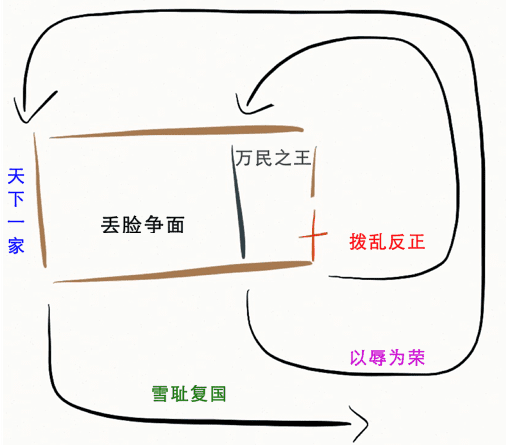 If you would like to download the graph above, click here (a bigger picture) or here (smaller jpeg).
If you would like to download the graph above, click here (a bigger picture) or here (smaller jpeg).
WHY THESE NAMES FOR THE STAGES?
In order to help people remember the big movements within the biblical narrative, it is helpful to give them “verbal hangers,” which capture the key idea of the period. As I have written elsewhere, the best theological contextualization occurs when our presentations highlight the prominent themes that overlap Scripture and the culture.
1. 天下一家 (tiānxià yī jiā): One Family Under Heaven
2. 丢脸争面 (diūliǎn zhēngmiàn): Losing Face, Seeking Face
3. 万民之王 (wànmín zhī wáng): King of All Nations
4. 拨乱反正 (bō luàn fǎn zhèng): Setting the World Right
5. 以辱为荣 (yǐ rǔ wéi róng): Honor through Shame
6. 雪耻复国 (xuěchǐ fùguó): God Vindicates His Honor & Restores His Kingdom
A few themes reappear in the section titles, such as family, kingship, honor and shame. The titles themselves attempt to convey the magisterial and cosmic scope of the Bible: “under heaven,” “all nations,” “king,” “world,” “kingdom.” In other words, we’re not talking about some local mythology about one particular deity among others.
The interweaving of themes helps creates coherency and maintains balance to the story. We do not want to present the grand story of Scripture in a half-baked way. Splicing together seeming disparate pieces will only confuse our listeners . . . not to mention ourselves.
In addition, the blending the themes within the titles keeps us from veering off track and overemphasizing one motif over against another. We need to recognize afresh that the various images in the Bible are intermingled. Thus, we do well to demonstrate their interrelationship as best we can within our own retelling of the Story.
In this post, I have simply tried to give an outline that summarizes grand biblical narrative. In order to clearly and concisely summarize the big story of the Bible, we ourselves have to
(1) be able to remember it, and . . .
(2) understand how the parts relate to each other.
Whether you like or don’t like the 6 points I have suggested, I think these principles are important to any model of biblical theology.
The next post begins to explain how to use the model.
If you would like a copy of the packet (in English) I made presenting this model, click here.
*** For a very scaled down version of the model in Chinese, click here.












